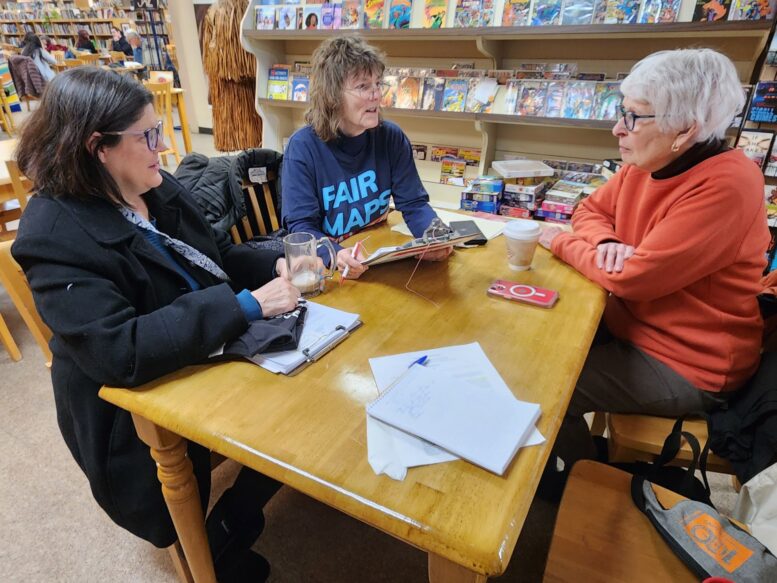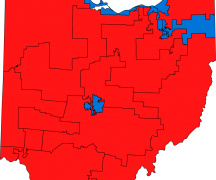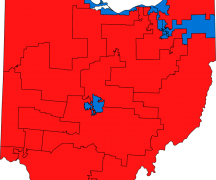By JAN McLAUGHLIN
BG Independent News
Ohio citizens still waiting for fair legislative maps have switched strategies. Their latest effort will try to take redistricting power out of the hands of elected officials.
Tired of waiting for state legislators to adopt maps that aren’t gerrymandered to benefit the party in power, citizens across Ohio are petitioning to get a constitutional amendment on the November ballot.
The “Citizens Not Politicians Amendment” is a citizen initiative to end gerrymandering. It bans lobbyists and politicians from the redistricting process and instead establishes an Ohio Citizens Redistricting Commission, empowering citizens to draw fair districts using an open and transparent process.
The key is removing elected officials – from both parties – from the process, said Bowling Green League of Women Voters member Debbie Dalke.
“They both try to create districts that increase the likelihood of being elected,” said Dalke, who is one of several people locally trying to collect signatures to get the issue on the general election ballot.
The commission would be responsible for adopting a redistricting plan for the Ohio General Assembly and new districts for the U.S. House of Representatives. The commission would draw maps with input from experts, such as demographers, not politicians, Dalke said.
Seven states have independent citizen commissions – Arizona, California, Colorado, Idaho, Michigan, Montana and Washington.
Ohio is known for its gerrymandered districts, like the “snake on the lake” and a duck shaped district – both created, in these cases, to guarantee more Republican legislators are elected or re-elected.
“The politicians know they are going to get elected no matter what, so they stop listening to the people,” Dalke said. “It fractures our communities.”
The 135th Ohio General Assembly was elected in 2022 under Statehouse maps declared to be unconstitutional gerrymanders five times by a bipartisan Ohio Supreme Court majority.
Despite a constitutional mandate to draw districts reflecting voter preferences, the Republican politicians controlling 5 of 7 seats on the Ohio Redistricting Commission ignored the court rulings, hired and then dismissed independent mapmakers, ran out the clock, and forced voters to cast ballots in unconstitutional districts.
Under a system of gerrymander-rigged elections, only primaries matter. The results of the legislative general elections are nearly all foregone conclusions. The only challenge a lawmaker might face is getting primaried by someone willing to be more extreme, Dalke said.
Janet Parks, also with the Bowling Green LWV, worries that the gerrymandered districts are creating a cynical electorate. For the most part, local citizens used to trust their state leaders, she said. But after so many times of refusing to provide fair districts, voters suspect their legislators of serving themselves, not their constituents.
“We need ordinary citizens to draw the maps,” Parks said.
The court has ordered five times that the maps be redrawn, “and we still have bad maps,” BG League of Women Voters member Shar Katzner said.
Many citizens don’t understand the gerrymandering process and the damage it can cause, Katzner said.
“It’s the backbone of democracy. Without that, we don’t really have a true choice,” Katzner said.
Dalke said the petitions being circulated for the citizens commission are just to get the issue on the ballot.
“It will be up to all Ohio voters to decide if we want this,” she said.
If passed, the Ohio Citizens Redistricting Commission would be made up of five Republicans, five Democrats, and five independents. It bans lobbyists and politicians from the redistricting process.
The citizens commission would eliminate the Ohio Redistricting Commission, a seven-member panel made up of all elected officials, five from the GOP majority and two Democrats.
An average of Ohio voter preferences in the last 10 election cycles shows a 56 to 43 Republican-to-Democratic split in voter preferences. But because of gerrymandered districts, Republican lawmakers have a 67 to 32 supermajority in the Ohio House, controlling 68% of the seats, and a 26 to 7 supermajority in the Ohio Senate, controlling 78% of the seats.
The amendment calls for a redrawing process in 2025 to replace the current Congressional and State House maps. That means new maps for the 2026 elections. Maps would again be drawn after the new census data comes out in 2031, and then every decade following the census.
The redistricting hearings would be accessible and transparent, with the citizen commission being required to conduct hearings inviting broad public participation across the state.
Prior to the release of a draft redistricting plan, the commission would be required to hold at least five public hearings to gather public input from geographic regions of Ohio, including the northeast, southeast, northwest, southwest and central.
After release of a draft redistricting plan, the commission would then hold at least five additional public hearings across the five geographic regions to receive public comment on the proposed districts.
The legal dispute over redistricting has been going on for two years, with the court rejecting two separate congressional maps and five sets of Statehouse maps — describing districts for the Ohio House and Senate in Columbus as gerrymandered in favor of Republicans.
Despite the maps being deemed unconstitutional before the 2022 elections, they continue to be used due to Republicans essentially letting the clock run out after refusing the court’s order to write up new, fairer maps by the prescribed deadline.
In late September 2023 — 16 months after the court-imposed June 2022 deadline for passing a new set of maps — a new set of legislative maps were approved, which fair district advocates deemed “illegally gerrymandered” in favor of Republicans.
Those maps will again be used in 2024.
Last week, during a meeting of the Bowling Green Republican Club, State Sen. Theresa Gavarone was asked by a local resident when Ohio would make its redistricting maps fair. Gavarone said that had already been done, but the media failed to report that news.
“We have constitutional maps,” created by a bipartisan commission, she said.
However, the two Democrats on the commission stated they stopped fighting the map less than two months before the general election because even if a newly redrawn map were to correct all of the deficiencies of the map used in 2022, it would be an expensive and lengthy process that would leave Ohio residents in limbo for at least several more months.




